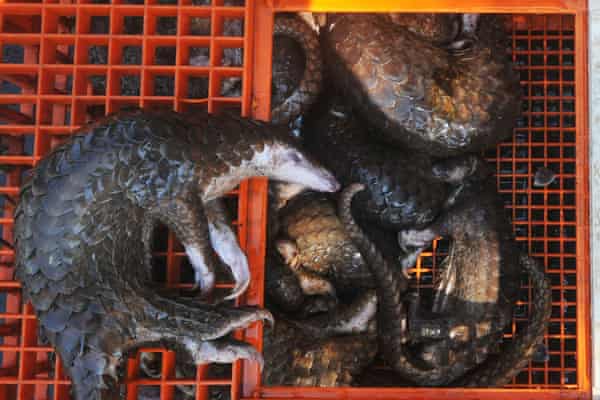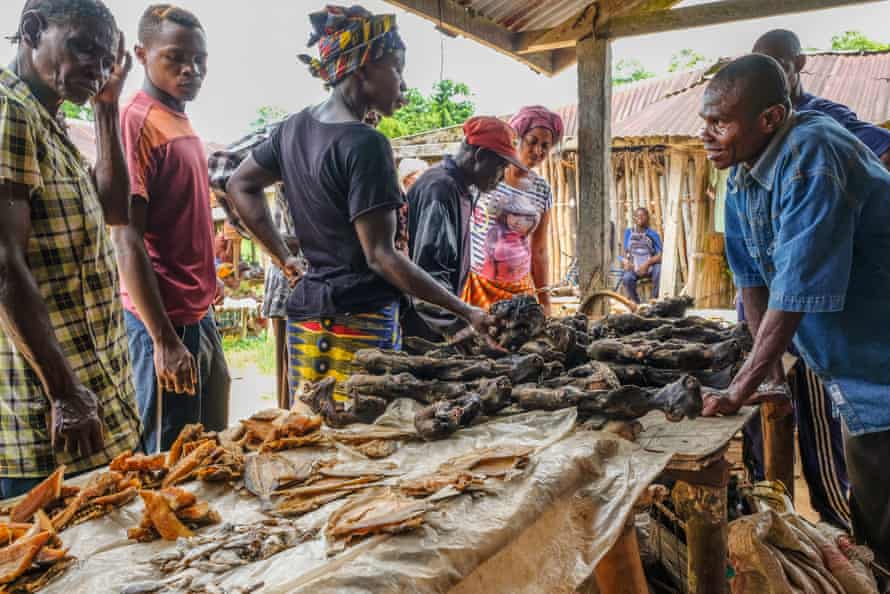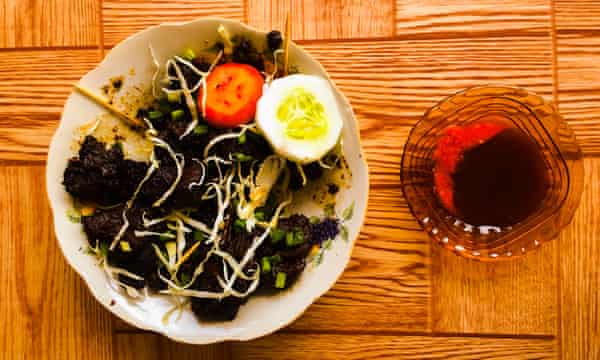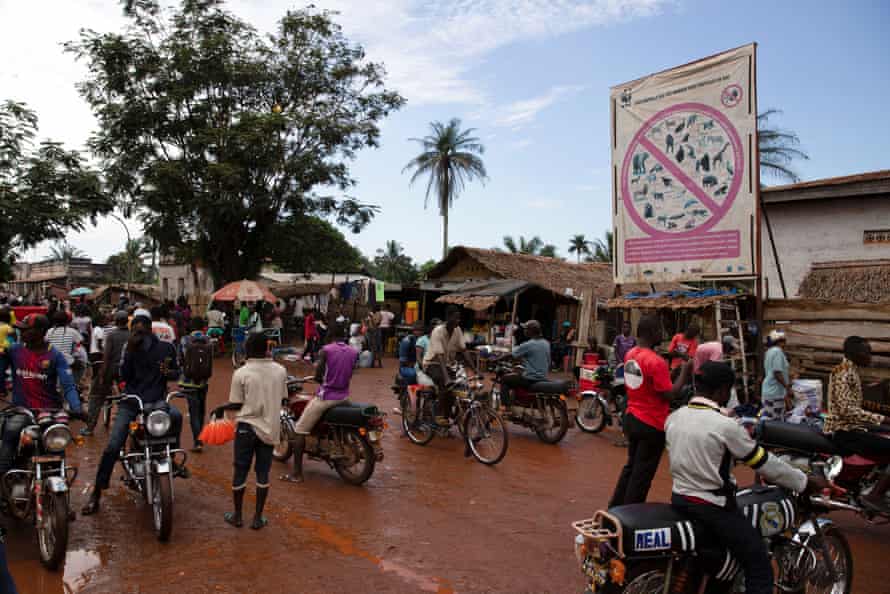Are Wild Animals Better To Eat Than Commercial
A ntelope is best, monkey is chewy, bats needs a sauce, forest porcupine is mild, and pangolin – one of the almost trafficked animals in the earth – tastes great roasted only smells awful. That, at to the lowest degree, was what the Gabonese workers told us.
We were in a Belgian-endemic logging camp in Gabon. The day had been spent watching giant trees being felled for the Chinese market but past evening anybody'south thoughts had turned to nutrient.
Near rural Africans and Asians say "bush" or wild meat is healthier, tastier and often cheaper than the banal meat of virtually farmed animals like chickens or pigs. The joke amidst the African loggers in the camp that night was that Asians would eat anything live in the forest but the squeamish Europeans would eat nix.
Today, equally a upshot of Covid-nineteen and its suspected origins in a Chinese "wet" market, governments and the World Health Organisation are coming nether growing pressure from conservationists, vegans, and animal protection, zoo, and welfare groups to non but terminate the hunting of all wild animals for nutrient merely to end the commercial trade in live animals with a global ban. Now is the time to link human health with biodiversity loss and animal suffering and to close all markets selling live or expressionless wild animals, they say.
While supermarkets selling chilled or frozen meats are increasingly pop in Asia, older shoppers generally adopt ownership freshly slaughtered meat for daily consumption, believing it produces flavor in dishes and soup that is superior to frozen meat.
"Moisture markets", where water is sloshed on produce to continue it absurd and fresh, may be considered unsanitary by western standards. Simply almost do not trade in exotic or wild animals and should not exist confused with "wild animals markets" – now the focus of vociferous calls for global bans.
The Wuhan South China seafood market, suspected to be a primary source for spreading Covid-xix in late 2019, had a wild animal section where live and slaughtered species were for sale, including snakes, beavers, badgers, civet cats, foxes, peacocks and porcupines among other animals.
","credit":"","pillar":0}"> Q&A What is a wet market?
Show
At the crack of dawn every day, "wet markets" in People's republic of china and beyond Asia come up to life, with stall owners touting their wares, such every bit fresh meat, fish, fruit and vegetables, herbs and spices in an open-air setting. The sights and sounds of the wet market course office of the rich tapestry of customs life, where local people buy affordable food, or only go for a stroll and meet their neighbours for a chat.
While supermarkets selling chilled or frozen meats are increasingly popular in Asia, older shoppers generally prefer buying freshly slaughtered meat for daily consumption, believing it produces flavour in dishes and soup that is superior to frozen meat.
"Moisture markets", where water is sloshed on produce to keep it cool and fresh, may be considered unsanitary past western standards. Simply about do non trade in exotic or wildlife and should not be confused with "wild fauna markets" – now the focus of vociferous calls for global bans.
The Wuhan South China seafood market, suspected to exist a master source for spreading Covid-19 in late 2019, had a wild brute section where live and slaughtered species were for sale, including snakes, beavers, badgers, civet cats, foxes, peacocks and porcupines amongst other animals.
Verna Yu
A spokeswoman for WWF Britain says: "We have called for the closure of illegal and unregulated wildlife markets, primarily in urban areas. What we are concerned nearly is the illegal consumption of highly threatened wild animals, often seen as a delicacy."
At that place is no doubt that wild meat hunting and consumption is heavily impacting the globe'due south wildlife, giving ascent to what is chosen "the empty forest", where few large mammals remain. A 2016 Purple Society newspaper shows that the bushmeat trade is growing fast, with devastating results. "Every bit wildlife populations outside protected areas decline, poaching pressure is increasing in many parks and reserves," say the authors. "Equally a effect many forests, savannahs, grasslands and deserts in the developing world are now condign 'empty landscapes' devoid of harvest-sensitive wild mammals."
What has changed over fifty years, say scientists, is the scale of the commercial wild meat trade. In the past, local subsistence hunters killed animals in small-scale numbers. Today a loftier-volume industry supplies fast-expanding Asian and African cities. No longer run by local hunters, it is helped by mod firearms and cellphones, and utilises a vast network of new roads driven deep into wood concessions by the international logging industry. Hunters can strip a forest or wetland in a few nights and access abode and consign markets for their meat. And as the forests are emptied of their animals, the price of wild meat soars and it becomes a luxury commodity for urban elites.

Sue Lieberman, vice-president of international policy at the New York-based Wildlife Conservation Gild, says that growing populations in Africa and Asia must switch to eating farmed animals. "People practise need other sources of nutrient [than bushmeat]. I am not saying that people should not swallow wildlife [but] in that location is not plenty to become round any more than. Commercialisation is the problem. The offset priority must be to stop the commercial markets. They can't get on. Practices that originated hundreds of years agone have to stop. The amount it would cost to provide chicken and farmed fish to anybody [in Africa] is negligible compared to what this pandemic is costing."
But critics of a ban say that the legal wildlife meat merchandise employs hundreds of thousands of people, provides protein for between 30 million and 70 1000000 people in Africa lonely and kills few threatened, or rare animals.
What about the environmental impacts of farming? Co-ordinate to a major 2011 written report led by Robert Nasi, managing director general of the Centre for International Forestry Research (Cifor), a switch to cattle to provide poly peptide in place of wild animals would have huge bear upon.
Hunters, says Nasi, have almost 4.5m tonnes of bushmeat a year from forests in the Congo basin and possibly 1.299m tonnes in the Amazon. "We would need to transform large areas of tropical forests or savannas into pasture to replace [this amount of] bushmeat past cattle. For comparing, Brazilian beef product is considered responsible for almost 50m hectares [124m acres – twice the size of the UK] of deforestation. If bushmeat consumption in the Congo basin was to be replaced by locally produced beef, an area every bit large as 25 one thousand hectares might take to be converted to pastures."
Factory farming has devastating effects on wild fauna, says Philip Lymbery, director of UK-based Compassion in World Farming. "It is a principal driver of wild animals decline and the devastation of the world's remaining wild lands," he says. "Information technology's about keeping animals caged in sheds, which sounds efficient but you have to devote vast areas of land to grow their feed. Information technology drives inroad into wild lands and the destruction of habitats.
"It would cause unimaginable suffering to the animals, and even more environmental destruction. It would also create the perfect breeding basis for the next pandemic. Manufactory farming and pandemics are strongly linked. The principal driver of future pandemics will be factory farming."

Many epidemiologists, ecologists, human rights and ethnic peoples' groups say a knee-wiggle global reaction to ban the wild meat trade could exist unscientific, counter-productive and culturally offensive.
The western conservation "manufacture" wants an terminate to the eating of wildlife because information technology wants vast new areas of country to exist "protected" in the name of increasing biodiversity, says Fiore Longo, advocacy officer of Survival International.
"Only this model of 'fortress conservation' is unsafe," she says. "Conservationists have seized the crisis as a chance to criminalise the means of life of a large part of the world's population. It reinforces the false separate between people and wildlife, and potentially vastly increases the size of protected areas whatever the homo cost may be.
"What happens if we outlaw the trade and consumption of wildlife where in that location are no other sources of protein bachelor? Practise nosotros let more people starve? Is a dependence on industrial food product with all its enormous ecology, health and financial impacts somehow 'better' than the sustainable consumption of wild animals?"

Photograph: Manuel Lopez/CIFOR
"It is important not to throw the baby out with the bathwater," says John Fa, coordinator of the Bushmeat Enquiry Initiative at Cifor. "Wild meat plays an of import role in the nutrition of large populations of humans, bookkeeping for upward to 50% of the protein intake of people in primal Africa. You can't just say to people: 'Yous tin't exercise it any more.'"
Wildlife hunting bans mostly neglect, says Stephanie Brittain, who spent five years in Cameroon researching bushmeat consumption and now works with Oxford University's Interdisciplinary Eye for Conservation Science. Afterwards the 2013–sixteen Ebola outbreak in westward Africa, she says, bans were brought in past several countries but could not be policed. The result was a marked increase in hunting for wild meat. "At that place [is] no conclusive bear witness that banning the wildlife trade will forestall the emergence of zoonotic diseases in the future," she says. "The legal merchandise for species that can exist safely harvested can facilitate improved hygiene and animal welfare, while complete bans tin can drive trade clandestine, resulting in illegal markets with lower hygiene regulation and increased risk of disease transmission."
Every bit for the idea that disease is more than likely to accompany wild meat, experts point out that illnesses similar Mers and Sars, BSE, swine and bird flu, E coli, MRSA and salmonella, originated in intensive poultry, grunter and livestock farms where the overuse of antibiotics and unhygienic conditions can spread disease speedily. Many are common. Co-ordinate to the OIE, the World Organisation for Animal Health, there are currently more than 25 outbreaks of H5 and H7 avian influenza having to be controlled in more than xx countries, including the The states, Germany, India and Saudi arabia. Whatsoever one, if unattended by vets, could develop into an epidemic.
"Intensive farming is an area that must also be looked at", says Eric Fevre, chair of veterinary infectious diseases at Liverpool University. "As nosotros select for better milk cows, better beefiness cows or amend egg-laying chickens, we create populations of animals that often alive in intensive atmospheric condition, only where the genetics are very similar. This creates risks for [the] emergence of diseases, because if these genetically compatible big populations are susceptible, things can spread very quickly."

Photograph: Thomas Nicolon/Reuters
Delia Grace, programme leader for food prophylactic and zoonoses at the International Livestock Research Institute, said: "Wet markets are basically fresh nutrient markets. In the Uk we similar farmers' markets with fresh cornfed chickens, farm-sourced meats and nice looking sausages. That'due south basically a wet market place, though in a different cultural context. They are essential to bring fresh food to urban populations, and provide for the food security of millions of people.
"They do need to be regulated and controlled. They should not exist coating banned, as that is not sensitive to the needs of their clients who depend on them."
Conservationists are struggling to diminish consumption of wild animals through behaviour campaigns, legislation and constabulary enforcement – especially in urban Africa, says Congo analyst Theodore Trefon, a researcher at the Belgian Majestic Museum for cardinal Africa.
"Many consumers [there] believe that eating bushmeat is quite simply normal, respectful of tradition, healthy, desirable and utilitarian," he says. "This is a well-known challenge to wild animals conservationists but one that is relatively new to public health experts confronted by known and all the same-to-come up zoonotic diseases."
This piece was edited on 27 May 2020 to analyze Stephanie Brittain'southward experience in Republic of cameroon and right the proper name of her institution
Source: https://www.theguardian.com/environment/2020/may/26/ban-on-bushmeat-after-covid-19-but-what-if-alternative-is-factory-farming
Posted by: cokerdiethat.blogspot.com



0 Response to "Are Wild Animals Better To Eat Than Commercial"
Post a Comment